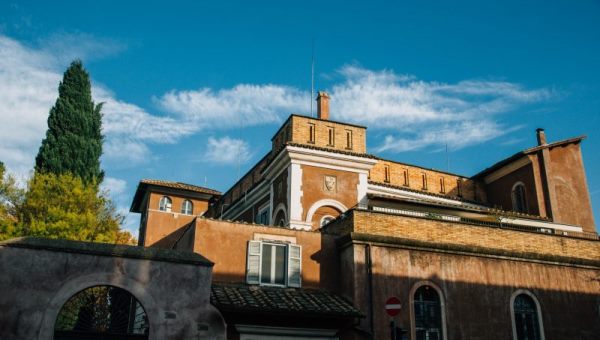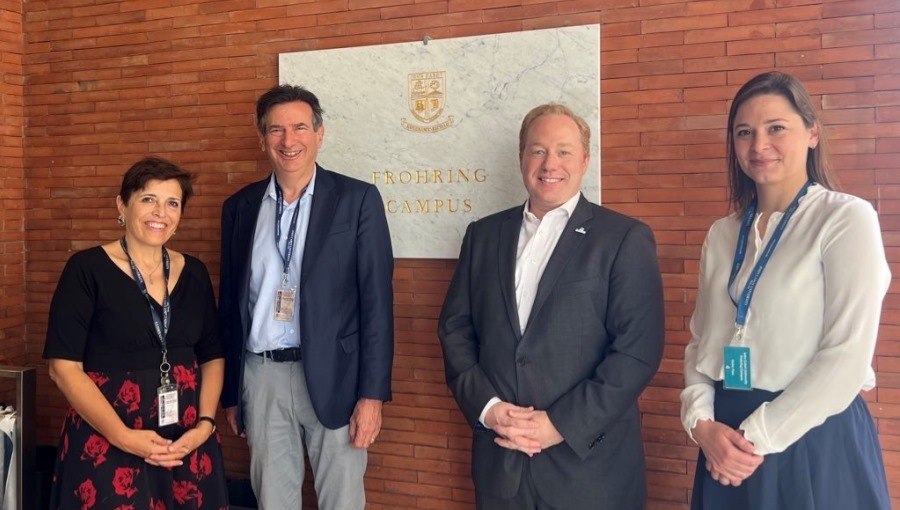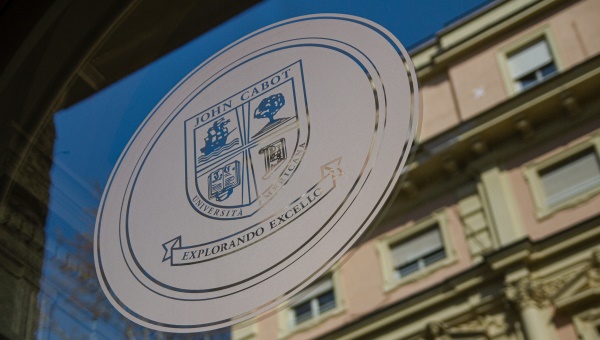Professor Riccardo Maiolini Welcomes Founders of Vision Studio
On November 6, Professor Riccardo Maiolini welcomed Francesco De Santis and Edoardo Maria Bisignagni to his Strategic Decisions in Entrepreneurship class. De Santis and Bisignagni are the founders of Vision Studio, a startup that operates in the digital art industry.
After the class, Professor Maiolini, who is Director of JCU’s Institute for Entrepreneurship, interviewed the two speakers.

What inspired you to start Vision Studio, and what unique opportunities or challenges did you identify within the marrying of entrepreneurship and the art world that motivated you to create this startup? Also, was there a key moment where you faced a specific challenge forcing you to pivot/adapt the way you did business?
The birth of Vision Studio was inspired not only by a shared passion for art and innovation but also by the unique opportunity that the art market presented during the COVID-19 pandemic, which highlighted the need to explore new approaches in the arts.
The main challenge was to figure out how to integrate NFTs (non-fungible tokens) and digital art in a context that would enhance the art itself, creating a tangible link between physical reality and the digital world. We aimed to offer a unique experience, creating a framework that could bridge these two dimensions, thus anticipating the evolution towards a ‘phygital’ environment that promises to be increasingly relevant.
The path has not been linear. We were initially working on a primarily hardware-based project, but we realized a more comprehensive approach was needed. We revised our business model, moving towards an integrated software and hardware solution. In addition, the experience of selling abroad forced us to adapt our commercial and production strategy to meet the needs of different markets.
Facing these challenges has led us to profound growth and given us a broader view of the business world. Constantly reviewing and adapting our path has taught us the importance of agility and flexibility in business, and this has been an extraordinary experience that has allowed us to grow and discover new perspectives.
The art world can be known for its traditional and established institutions. How have you navigated this landscape and introduced innovative approaches or technologies to disrupt or enhance the art market?
In the art world, particularly in Italy, we have moved carefully, aware of this thousand-year-old market’s deep roots and established traditions. Our strategy has been to gradually introduce innovations, seeking to gain space without destabilizing the traditional fabric. We have adopted a respectful approach towards the institutions and practices established in the art market. Our vision is to offer an alternative that integrates technological innovation without compromising the values and authenticity that characterize the art sector.
We value the fundamentals of the art market, such as the quality of materials and care in selecting works on display. However, we introduced innovative elements such as technology to unite the physical and digital worlds. We aim to bridge traditional art and contemporary innovation, creating a balance that allows artistic authenticity to be preserved while embracing the new possibilities of emerging technologies.
We wish to be an opportunity for growth and evolution rather than agents of a destructive revolution. Our commitment has been to create an environment where art can flourish, embracing the opportunities offered by modernity without compromising respect and appreciation for the historical and cultural roots of art itself.
How do you balance the artistic and entrepreneurial aspects of your venture, and what advice would you give to aspiring entrepreneurs looking to enter the art industry?
Launching a startup requires a combination of creativity, vision, entrepreneurial skills, and a good dose of courage. Finding the balance between a business’ artistic and entrepreneurial aspects can be challenging, but it is crucial for success in the art world.
One essential thing in entrepreneurship is having a cohesive and competent team. Working together in a strong team enables one to face challenges and overcome obstacles. Different perspectives and skills can lead to innovative and creative solutions.
In addition, being courageous and determined is essential. Entrepreneurship requires constant commitment and a willingness to overcome seemingly insurmountable obstacles. Always push the limits because satisfaction and success often come when one dares to face the most difficult challenges.
Passion is essential for those who wish to enter the art world through an entrepreneurial venture. Always remain passionate about your work and keep your curiosity for artistic details alive. Art is a world full of nuance and history, so keeping yourself fascinated by this universe will help drive your creativity and motivation.
Being open to innovation is another critical aspect. The art world is experiencing rapid changes thanks to new technologies. Keep your eyes open, explore the new possibilities of emerging technologies, and be willing to use these opportunities to innovate and adapt your proposals to the art market.
Finally, flexibility and adaptability are essential in such a dynamic environment. Be prepared to learn from experiences, adapt your strategies, and remain agile in the face of market changes.
Building a startup in art requires passion, courage, open-mindedness, collaboration, and a constant desire to learn. Entrepreneurs can start innovative and successful art projects by focusing on these aspects.
How do you view the long-term sustainability and impact of NFT art on the traditional art market? What opportunities and challenges do you foresee for artists and collectors?
NFT technology has a massive potential for expansion in the art world, as it introduces new possibilities and transaction models that were traditionally not part of the art scene.
Regarding long-term sustainability, NFT offers a new paradigm of authenticity, transfer of ownership, and remuneration for artists. However, there are several challenges. One of the main obstacles is the need to educate the general public about the effectiveness and value of digital artworks certified through NFT.
In the international context, the attachment to traditional forms of art may not be as pronounced as in Italy. However, the opportunity for artists to make their way through NFT and get the recognition and value they deserve is tangible.
For artists, NFTs represent a way to obtain fair remuneration and more control over their works. Moreover, they offer the possibility of reaching a global audience without geographical limitations. However, artists need help getting their work recognized in a saturated and competitive market where innovation is rapid, and competition is fierce.
For collectors, NFTs offer the opportunity to own unique digital works of art with a chain of ownership and authenticity guaranteed by blockchain technology. However, the main challenge for collectors is the understanding and acceptance of this new paradigm within the art collection, which is often anchored in materiality and tradition.
Although NFT offers revolutionary opportunities for artists and collectors in the art world, it is essential to address the challenges of educating the public and setting new standards to ensure a smooth and sustainable transition to this form of certified digital art.
How do you envision the art industry evolving in the next 5 years, particularly in terms of technology and digital platforms? What role do you see Vision Studio playing in this transformation?
The future of the art industry in the next five years will be characterized by a fantastic evolution, especially in the area of interactivity and technology integration. Art is transforming into a more immersive and participatory experience for viewers.
Innovative technologies such as artificial intelligence (AI) and the Metaverse will significantly impact the arts sector. AI could be used to create generative artworks or to enhance the user experience in digital art platforms. At the same time, the Metaverse will offer new possibilities to develop and share paintings in three-dimensional virtual environments.
Vision Studio aims to play a crucial role in this rapidly evolving scenario. Our vision is to make art more interactive and accessible by integrating IoT (Internet of Things) devices in our frames, turning them into fundamental tools for interacting with artworks. This will allow viewers to become integral to the artwork, living a unique and immersive experience.
We are also exploring expansion into the holographic sector, allowing artists to express themselves through new forms of three-dimensional visualization. This technology will present artworks as innovative and immersive, helping expand artists’ creative possibilities.
In addition, we are already investing resources in developing immersive experiences within the Metaverse. Using technologies that enable the creation of 360-degree virtual exhibitions, we explore new ways of exhibiting artworks in entirely virtual environments, thus opening doors to new audiences and offering unique experiences to art enthusiasts.
Ultimately, Vision Studio aspires to be at the forefront of the adoption of innovative technologies, helping to shape the future of the art industry through interactivity, immersion, and the creation of new ways to enjoy and present artworks.





